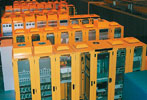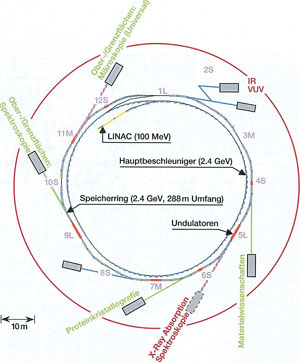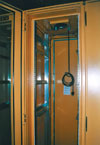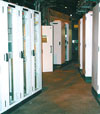
Synchrotron light is tightly-bundled electromagnetic rays, with wavelengths from UV light to severe X-rays. This is created when fast electrons that circulate in an accumulator ring are forced onto cam tracks.
The range of its application possibilities stretches from structure research in biology, physics, chemistry and material research to nano-technology.
The systems that drive and control the SLS (Synchrotron Lichtquelle Schweiz) at the Paul Scherrer Institute (PSI) in Switzerland are housed in 600 Proline cabinets from Schroff. (Figure 1). The Paul Scherrer Institute is a multidiscipline research institute for natural and engineering sciences that works closely with other national and international universities, research institutes, technical colleges and industry. With its staff of 1200 it is the largest research institute in Switzerland. Its specialist fields are solid-state research and material sciences, molecular and astrophysics, biology and medicine, energy and environmental research.

The PSI makes its laboratories available to universities and industry. More than 1400 guest researchers per year carry out experiments at Synchrotron Lichtquelle Schweiz (SLS), the Spallations-Neutronenquelle (SINQ), on instruments with myons (SmS) and in particle physics. The radiation created at PSI is used in the medical sector. In the new proton therapy unit, the rays are used to destroy deep-seated tumour tissue. Until now more than 200 patients have been treated successfully.
High brilliance and stability
The SLS (Figure 2) is based on an accumulator ring and it delivers rays with outstanding brilliance and stability for eight current experimental sites. In total, 30 stations can be erected around the ring. The SLS accelerator unit consists of three main parts: the linear accelerator (LINAC), the booster (main accelerator) and the accumulator ring. The booster accelerates the electrons of the linear accelerator to an end energy of 2,4 GeV. The booster has a circumference of 270 m and consists of 237 magnets as well as a row of further elements such as a high frequency station, vacuum and diagnostic system. The magnets are supplied by the magnet-feeding units with a capacity of 800 A and approx. 1000 V d.c. After the extraction from the booster, the electrons are injected into the accumulator ring. Inside the accumulator ring, these high energy electrons (life span approx. 10 hours) circulate and thereby produce the desired synchrotron light, which is fed in various beam lines to the different experimental sites. Inside the radiant tube for the electrons, an ultra high vacuum is required, so that the electrons are not lost through collision with air particles.

The SLS accumulator ring has a circumference of 288 m with 330 magnets, in which 12 straight lines of different lengths are incorporated in total. With this, the entire spectrum from ultraviolet to hard X-rays, can be covered. The electron ray emitted from the synchrotron light is very intensive: a medium capacity of 200 kW. This capacity is fed back to the electrons via high-frequency boosters, which work at a frequency of 500 MHz. A very complex diagnostic system keeps the position of the electron beam constant within 1 μm. This guarantees a very high stability of the light beam and X-rays on the examples to be tested. The accumulator ring and the booster are in a screened tunnel, the linear accelerator is housed in a concrete bunker.
Stable cabinets for flexible assembly
For housing the essential control and regulation devices to control the beam, the vacuum and the diagnostic system, the overall control system and the magnet feeder units, hundreds of Proline cabinets from Schroff are used (Figure 1). The principal requirement of the cabinets, apart from the predetermined measurements of 900 mm depth, 600 mm width, variable height and 19" assembly, was the simple handling during installation of components. Therefore all cabinets are equipped with front and rear doors, with front doors being equipped with an additional viewing insert. Furthermore, the integration of a fan with high air throughput of aprox. 900 m³/h respectively 1200 m³/h had to be possible, which supports natural convection.
Important was also the ability to arrange the cabinets side by side and the high stability of the cabinets, as due to the construction of the entire plant, the cabinets had to be transported by crane. EMC was taken into account during the construction of the entire hall with a potential equalisation on walls, inside the floor and on the cable ducting troughs. After all, four 1,6 MW transformers are installed in the technical gallery.
The cabinets all stand on a hollow surface; the AC cabling is carried on the outside of the cabinet consoles. Only short shielded cables lead into the cabinets and from there via the base channels back into the ring tunnel. From the start, good separation on the individual systems and frequencies had been taken into account. EMC protection of the individual cabinets is not required.
Two 'standard' versions
The Proline cabinets fulfil all demands and offer a very good price/performance ratio. The cabinets are based on a welded steel frame with 25 mm grid and are constructed for a load-carrying capacity to 600 kg (Figure 3). Through an extensive range of assembly and accessory parts, simple and flexible internal assembly is possible. As this cabinet range is also used for installation for electronics at the different experimental sites (Figure 4), flexible assembly and conversion play a large role. In particular for PSI, the cabinets were manufactured with a special depth of 900 mm and special panel/slide mounts for the internal assembly. Most of the cabinets are 47 U, ie, 2200 mm + 100 mm plinth height. Principally, two cabinet versions were determined, one for the assembly of the control cabinets and a second for the assembly of the magnet feeder units. Inside the cabinets that house the heavy magnet feeder units, particularly-strong guide rails, and additional 19" plinths are used so that the entire depth can be utilised. Despite the high weight in these cabinets, no additional strengthening is required. The fans that assist the natural convection are installed in the cabinet tops. The function of the fans is monitored with an installed air stream switch.

Two different colours of cabinets were supplied. The yellow colour of the cabinets for the utility systems is customer-specific, for the experiments the cabinets are provided in the standard light-grey colour RAL 7035. The supplied preassembled cabinets are then equipped with the corresponding components and systems and wired.

To avoid access to installed components by unauthorised persons, the cabinets are equipped with special inserts, the Kaba-Security-Cylinders that are common in Switzerland. The standard locking systems of the Proline cabinets were easily adjusted to this.
| Tel: | +27 11 608 3001 |
| Fax: | +27 11 608 1918 |
| Email: | [email protected] |
| www: | www.actum.co.za |
| Articles: | More information and articles about Actum Electronics |
© Technews Publishing (Pty) Ltd | All Rights Reserved